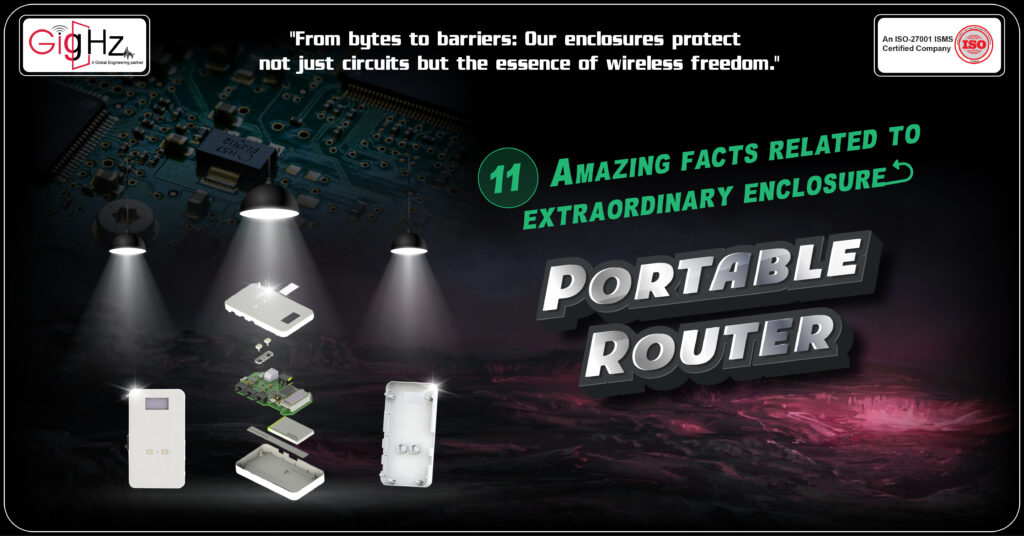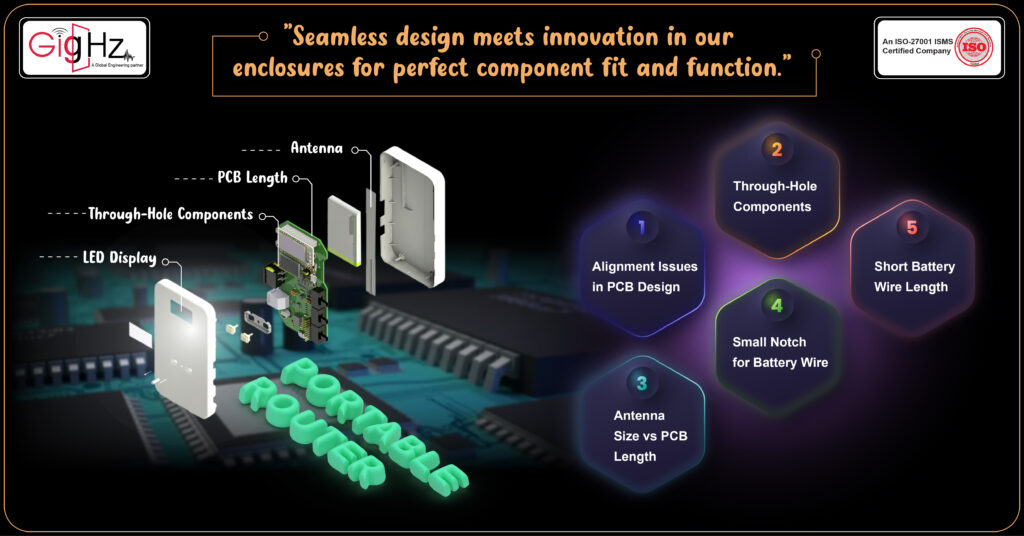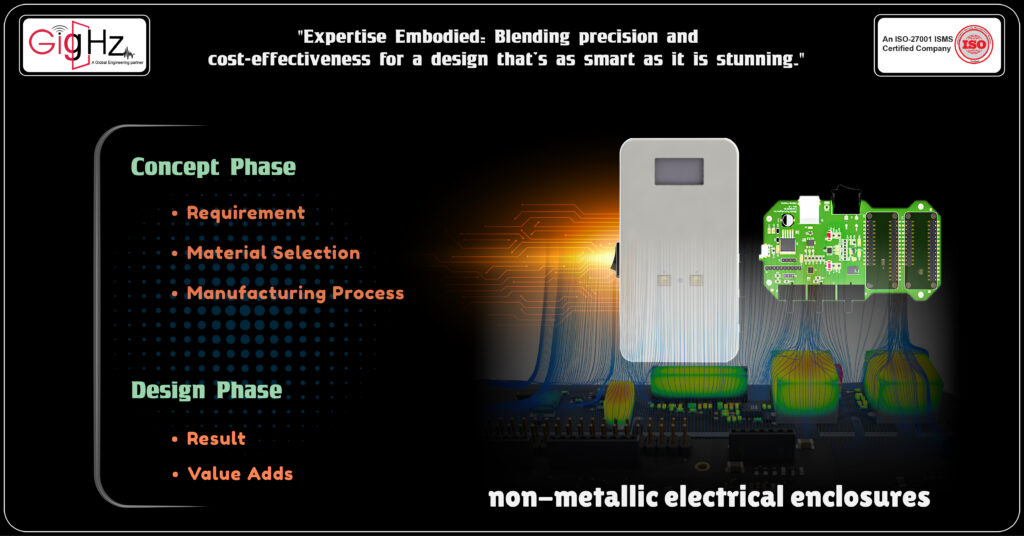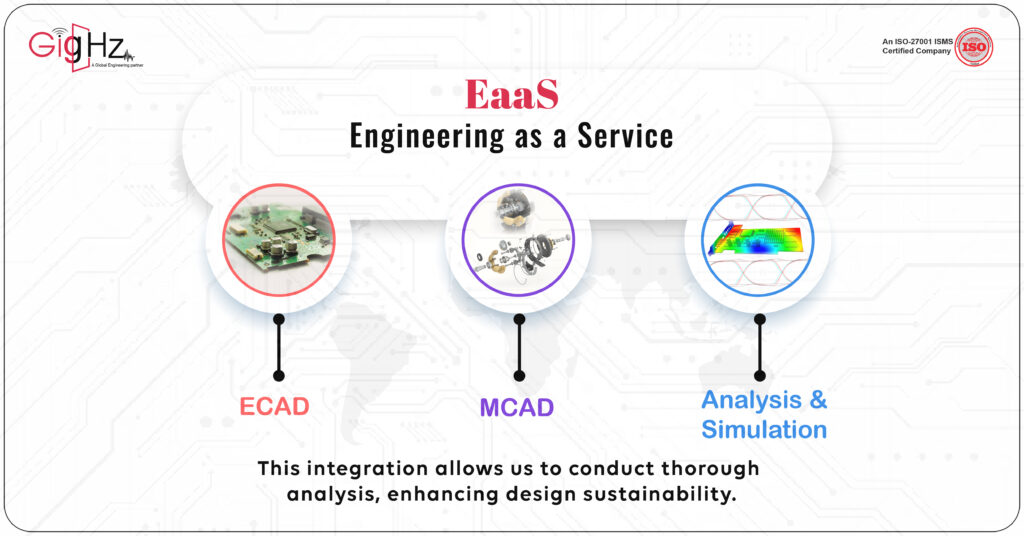11 Amazing facts related to extraordinary enclosure for Portable Router
In the ever-evolving world of technology, routers have become an indispensable part of our lives, connecting us to the vast digital realm. But have you ever wondered about the intricate process behind designing the protective enclosure that houses these technological wonders?
Designing an enclosure for a router is no simple task.

In the ever-evolving world of technology, routers have become an indispensable part of our lives, connecting us to the vast digital realm.
But have you ever wondered about the intricate process behind designing the protective enclosure that houses these technological wonders?
Designing an enclosure for a router is no simple task.

Category :
Published Date :
March 7, 2024
Category :
Published Date :
March 7, 2024
Category :
Published Date :
March 7, 2024
It requires a comprehensive process that begins with the selection of materials, manufacturing processes, and surface finishes.
Precision is paramount during this stage, as the layout must accommodate various components, connectors, and circuitry necessary for both LAN and Wi-Fi capabilities.
In this blog, we will take you through the challenges faced by our team when designing a protective case for a portable router circuit board and how we overcame them with precision and innovation.
Our Successful Journey of Enclosure for Portable Router
What the challenges we faced?

At our company, we specialize in providing comprehensive MCAD Engineering Services, including designing enclosures for various electronic devices.
When approached by a client with a request to design a protective case for their portable router circuit board, we knew it would be a challenging yet exciting project.
The client presented us with several specific challenges:
Alignment Issues in PCB Design:
The LED display and the switch with LED were not properly aligned within the PCB.
We had to address this issue to ensure that the components fit perfectly within the enclosure.
Through-Hole Components:
The PCB contained through-hole components, which posed a challenge when designing the enclosure.
We had to find innovative solutions to accommodate these components without compromising the overall design.
Antenna Size vs. PCB Length:
The antenna size was larger (122.3mm) than the length of the PCB (96.52mm). This required us to carefully consider the placement and spacing of the antenna to ensure optimal performance without hindering other components.
Small Notch for Battery Wire:
A small notch was needed at the bottom of the enclosure to allow the battery wire to pass through. We had to design this feature in a way that provided proper protection and strain relief for the wire while maintaining the structural integrity of the enclosure.
Short Battery Wire Length:
The battery wire provided was shorter than usual, which required us to plan accordingly during the enclosure design. We had to ensure that the wire could be securely connected to the PCB without any strain or tension.
Idea Exploration for the Challenges
Improper Alignment in PCB Design:
The PCB (Printed Circuit Board) is the heart of any electronic device, and it needs to fit seamlessly within the enclosure. However, in this case, there were issues with improper alignment between the PCB and the desired enclosure dimensions.
We had to carefully analyze the PCB layout, identify the misalignments, and make necessary adjustments to ensure a perfect fit.
Through-Hole Components:
Traditional through-hole components, while effective, can pose challenges when designing an enclosure. Their physical presence can interfere with the overall shape and layout of the enclosure.
To tackle this, we employed creative design techniques such as repositioning components, utilizing smaller surface-mount alternatives where feasible, or creating specialized cutouts in the enclosure to accommodate the through-hole components without compromising functionality or aesthetics.
Size Discrepancies between Antenna and PCB:
Another challenge we encountered was the difference in size between the antenna and the PCB. It was crucial to find a harmonious balance where both components could coexist within the enclosure without hindering each other’s performance.
We carefully studied the antenna specifications, the PCB layout, and conducted simulations to determine the optimal positioning and spacing to avoid signal interference.
Small Notch Requirement for Battery Wire:
The client requested a small notch in the enclosure to accommodate the battery wire.
This seemingly simple requirement posed its own set of challenges.
We had to consider factors such as wire protection, strain relief, and maintaining the structural integrity of the enclosure while ensuring easy access for battery replacement.
Short Battery Wire Length:
Lastly, the client provided us with a short battery wire length, which required careful consideration during the enclosure design. We needed to ensure that the wire could be properly connected to the PCB while allowing for a secure and reliable power supply without any strain or tension on the wire.
How we Overcome the Challenges?

So, let’s unravel the nitty-gritty details of the Statement of Work (SOW) we initiated, focusing on the Concept Phase and Design Phase.
Buckle up, because this is where things get seriously technical and intriguing.
Concept Phase
In the Concept Phase, we dived headfirst into a whirlwind of activities.
First up – Requirement
We were handed crucial intel about the antenna, battery, a 3D step file for the PCB, and a detailed document containing additional specifics.
Our task? To mold this wealth of information into a meticulously organized, step-by-step order. And that’s exactly what we did.
Next on the agenda – Material Selection
The conditions were crystal clear – the chosen material had to be transmission-friendly (creating minimal interference with airwave signals) and boast unwavering durability.
After careful consideration, Polycarbonate emerged as the undeniable champion.
Known for its toughness in the realm of non-metallic electrical enclosures, it checked all the boxes, combining lightweight properties with exceptional durability and minimal interference with airwave signals.
Now, let’s talk,
Manufacturing Process Selection
We needed processes that could deliver parts with tight tolerances, exceptional part-to-part repeatability, all while keeping an eye on costs and ensuring fast cycle times.
The outcome?
3D printing for prototypes and injection molding for mass production. A winning combo for efficiency and cost-effectiveness.
But wait, there’s more!
Sketching and Detail took center stage
The initial sketch revealed room for improvement in the aesthetic department.
In response, not only did we embark on crafting the enclosure design, but we also took on the challenge of revamping the PCB layout.
The proposed sketch, complete with a new board shape, was the game-changer that breathed new life into the design.
Design Phase
Fast forward to the Design Phase.
This was where the magic happened – CAD Model development stages that left no stone unturned.
From outlining the design to adding intricate details and optimizing for enhanced aesthetics, each phase culminated in a stunning final CAD model.
Results and Value-Adds
Result:
The final design of the protective case for the portable router circuit board had dimensions of 74.64 x 134 x 1.6 mm.
It included allocated compartments for mounting the battery and antenna, ensuring a secure fit. The design was created without the need for screws, making it more user-friendly and convenient.
Value Adds:
- Precision and Expertise: Our team demonstrated precision and expertise throughout the project, addressing challenges such as improper alignment in PCB design and containing through-hole components effectively.
- Cost-Effectiveness: We provided a cost-effective design solution while maintaining the highest quality standards. Our efficient manufacturing process saved time and money for the client.
- Aesthetics Improvement: We improved the aesthetic appeal of the PCB design, resulting in a visually pleasing enclosure that enhances the overall look of the portable router.
- Swift Turnaround: Despite the complex challenges, we were able to complete the project within a short timeframe, exceeding the client’s expectations.
- Positive Feedback: The client provided positive feedback, praising our creativity, commitment to quality, and cost-effectiveness. This testimonial reflects the value we added to their project.
11 Amazing facts related to extraordinary enclosure for Portable Router

Here we decided to share the amazing facts related to extraordinary enclosure for portable router, what we determined through our results,
Here are 11 intriguing and technical facts about extraordinary enclosures for portable routers:
Fact 1:
Enclosures for portable routers employ advanced thermoplastic materials, such as ABS (Acrylonitrile Butadiene Styrene) or polycarbonate, known for their excellent mechanical strength and resistance to impact.
Fact 2:
To enhance thermal management, some enclosures feature integrated heat sinks or heat pipes to efficiently dissipate heat generated by the router’s components, ensuring prolonged performance and reliability.
Fact 3:
High-end enclosures utilize EMI/RFI shielding techniques, such as conductive coatings or gaskets, to minimize electromagnetic interference and maintain signal integrity.
Fact 4:
Enclosure designs often incorporate intricate vent patterns and chamfers optimized through computational fluid dynamics (CFD) simulations to facilitate optimal airflow, reducing the risk of overheating.
Fact 5:
Enclosures for outdoor or industrial-grade portable routers undergo rigorous environmental testing, including IP (Ingress Protection) ratings, to ensure they can withstand exposure to water, dust, extreme temperatures, and vibrations.
Fact 6:
In order to meet specific industry standards and certifications like UL (Underwriters Laboratories), enclosures undergo stringent flame retardancy tests, ensuring they are resistant to fire hazards.
Fact 7:
Advanced enclosures may feature modularity options, allowing for customization with additional modules or expansion cards, enabling users to adapt the router to specific requirements.
Fact 8:
Enclosures designed for deployment in hazardous environments, such as oil rigs or chemical plants, undergo specialized certifications like ATEX or IECEx to guarantee they meet stringent safety regulations.
Fact 9:
Some enclosures integrate intelligent locking mechanisms or biometric authentication features to enhance security, protecting sensitive data and preventing unauthorized access.
Fact 10:
Enclosures with integrated wireless antennas utilize advanced antenna design techniques, such as MIMO (Multiple-Input Multiple-Output), to optimize radio frequency performance and improve wireless coverage.
Fact 11:
Advanced manufacturing techniques like multi-shot injection molding enable enclosures to have complex geometries, integrating ergonomic features and reducing the number of assembly components for enhanced reliability.
Our Notable Upgrade: Engineering as a Service (EaaS)

The demand for advanced and integrated engineering solutions is soaring, and our Engineering as a Service (EaaS) is truly stepping up its game.
By harnessing the power of ECAD, MCAD, and Analysis & Simulation, we’ve positioned ourselves as frontrunners in this industry.
What’s really cool is that we offer a full package, covering every single step of the engineering process.
It’s this kind of approach that’s going to shape the future of our engineering, and honestly,
it’s super exciting stuff!
Why we do?

Our drive originates from the complex collaboration between our MCAD Capabilities with the embracing technologies.
Despite these intricacies, we set ourselves apart by employing distinctive strategies and a process centered on value.
This unique approach leads to a significant 52% reduction in costs, while simultaneously improving operational efficiency by 25%.
Conclusion
Our team triumphed every step over challenges to craft the Enclosure which includes routers. through relentless brainstorming and our prowess in these MCAD Engineering Services.
The ultimate design boasts a material selection that minimizes interference with airwave signals and offers exceptional rigidity. It’s a cost-effective blueprint that paves the way for efficient manufacturing of the product.
Schedule a Demo call. Book a Free Consultation now. https://calendly.com/gighz/30min
Achieving this milestone within a tight timeframe marks a pivotal juncture in our journey.
Discover our Specialities. Visit our Services Page. https://gighz.net/services/
